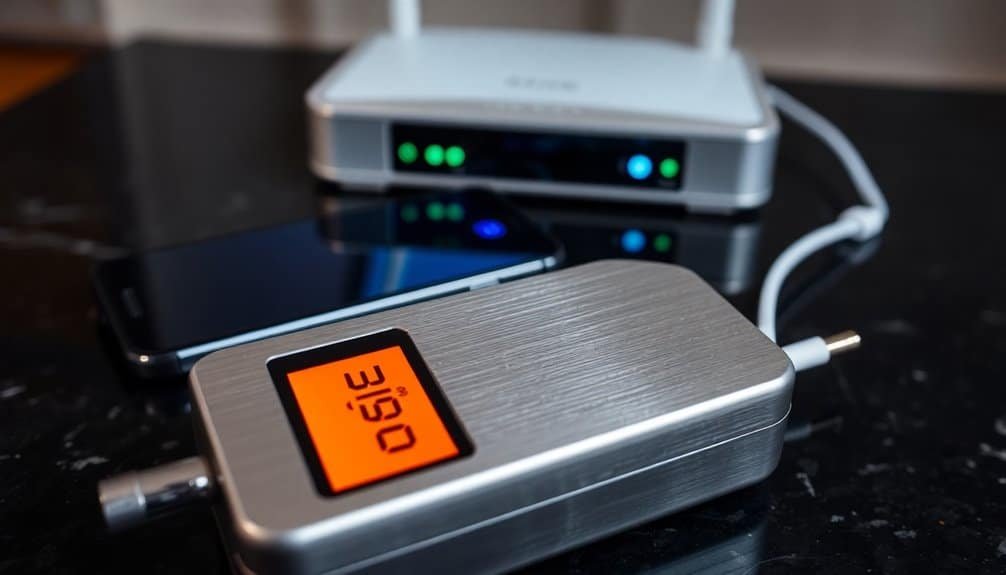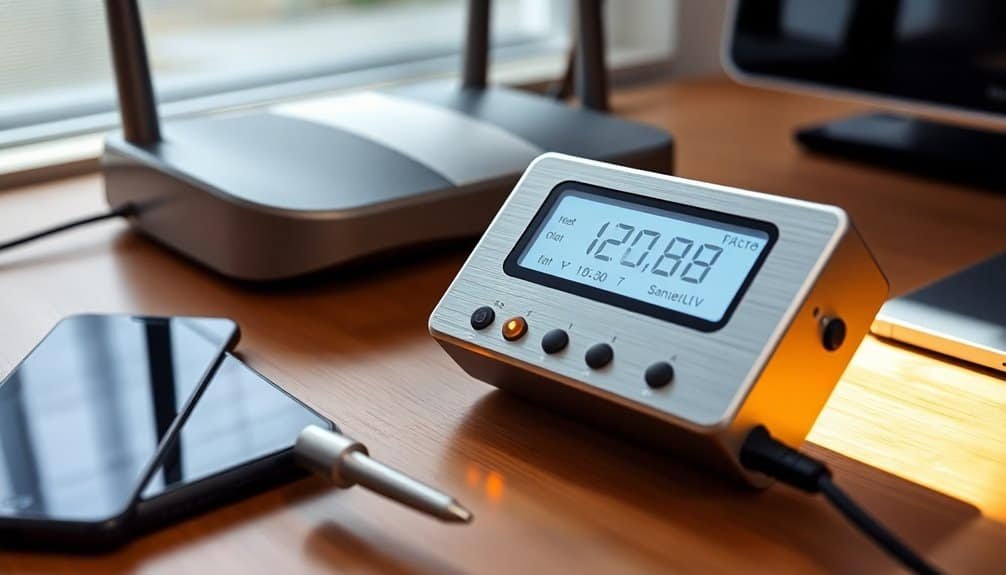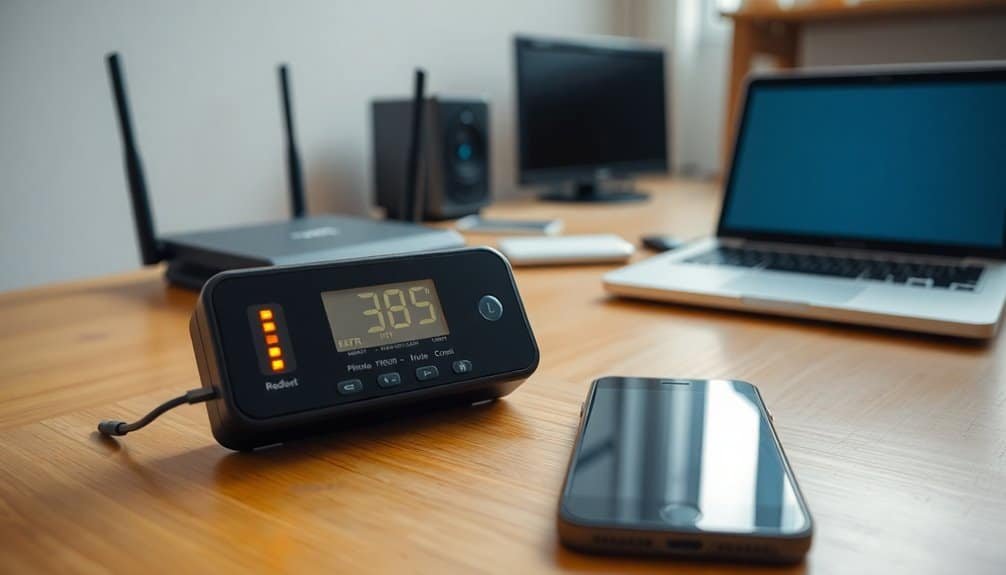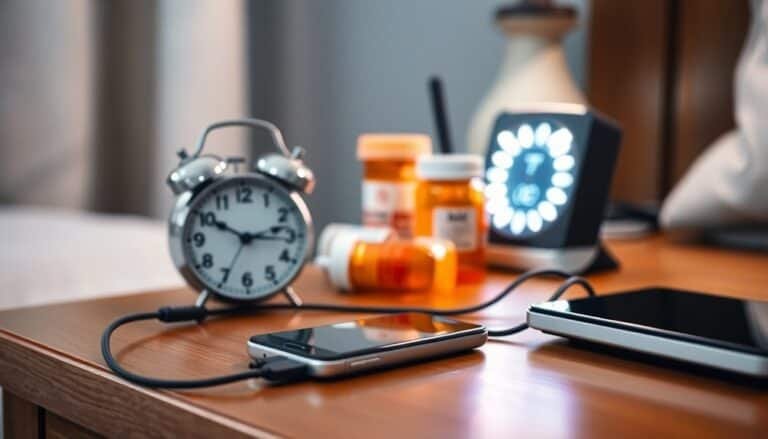Monitoring Your EMF Exposure (Personal Safety)
Monitoring EMF exposure is crucial for safety in a tech-driven world, as different appliances and devices contribute varying levels of EMFs based on location and usage. Use handheld EMF meters or personal monitors to measure high-frequency radiation accurately.
Factors such as proximity to power lines and building materials affect exposure levels, so implement strategies like reducing device usage and adding shielding to minimize risks. Understanding these factors empowers effective management of your EMF exposure.
Disclaimer: As an affiliate, I may collect a share of sales from the links on this page.
Understanding EMF Exposure

When you consider the various sources of electromagnetic fields (EMF) in your environment, it’s important to grasp their basic characteristics and potential effects.
EMFs consist of electric and magnetic fields, generated by both natural and artificial sources. You can categorize EMFs into low-frequency fields, like those from power lines, and high-frequency fields, including radiofrequency from mobile phones and Wi-Fi routers. Electric fields exist regardless of device status, while magnetic fields are present only when current flows. Radio waves can also contribute to the EMF exposure encountered in daily life.
Common sources in your daily life include electrical appliances, which can induce small currents within your body.
While international research focuses on potential health impacts, especially cancer links, low-level exposure generally shows no conclusive harmful effects in scientific studies.
Measurement Techniques for EMF Levels
Measuring electromagnetic fields (EMF) involves several techniques tailored to assess both electric and magnetic fields with precision. Each method suits different applications, ensuring accurate measurements:
- Standard Field Method: Compare against a known reference field for accuracy.
- Gauss Meters: Measure magnetic fields, often in the extremely low frequency (ELF) range. Power lines are a significant source of EMF radiation due to the high-voltage electrical currents they carry.
- Wireless Radiation Meters: Assess power density in high-frequency ranges like RF and microwaves.
- Calibration: This process enhances measurement accuracy by aligning with established reference standards. Regular monitoring is essential to identify unsafe environments and ensure that exposure levels remain within safe limits.
You can effectively monitor EMF exposure by understanding these measurement techniques and selecting the appropriate method based on your needs.
Tools to Measure Your EMF Exposure

Understanding the tools available for measuring your EMF exposure is essential for maintaining a safe environment. Handheld EMF meters provide real-time spectrum analysis and can measure frequencies from DC to 90 GHz. Area monitors offer continuous tracking in larger spaces and may include alert systems for exceeding safety standards. Personal monitors, designed for wear, deliver ongoing feedback on individual EMF levels, while RF EMF meters measure high-frequency radiation up to 8 GHz. Many devices comply with international standards, ensuring accuracy. Features like data logging, auditable alarms, and customizable thresholds enhance user experience and promote safety in daily environments. Utilizing continuous monitoring systems can further assist in tracking EMF exposure in various settings.
Factors Influencing EMF Levels
The level of electromagnetic field (EMF) exposure you experience is influenced by various factors, including your proximity to EMF sources.
Here are key elements affecting EMF levels:
- Distance to Power Lines: Stronger fields are directly beneath power lines.
- Appliance Usage: The more appliances in use, the higher your exposure.
- Urban vs. Rural: Urban areas have denser infrastructure and higher EMF levels.
- Building Materials: Different materials affect the penetration of EMFs indoors.
Understanding these factors helps you assess and manage your EMF exposure effectively.
Monitoring your environment can notably impact your overall health and safety regarding EMF levels.
Strategies to Minimize EMF Exposure

Recognizing the factors influencing EMF levels empowers you to adopt practical strategies for reducing exposure in your daily life.
Start by using shielding devices like Faraday cages for routers and avoid placing devices near living areas. Unplug appliances when not in use to cut emissions. Choose low-EMF alternatives for personal appliances and maintain distance during usage.
In bedrooms, remove electronics and avoid electrical panels nearby. Implement power strips for easy disconnection.
For workspaces, design environments to keep EMF sources away and educate colleagues on EMF risks.
Together, these strategies help you minimize EMF exposure effectively.
Frequently Asked Questions
How Can I Determine Safe EMF Exposure Levels for My Home?
To determine safe EMF exposure levels in your home, use a handheld EMF meter to measure field strength. Keep readings below 5,000 milliGauss for general safety, while maintaining distance from high-field appliances for better results.
Are There Any Symptoms of EMF Overexposure to Watch For?
You should watch for symptoms like skin irritation, headaches, sleep disturbances, mood swings, and fatigue. If you notice these, it might indicate overexposure. Staying aware can help mitigate potential effects on your well-being.
Which Devices Typically Emit the Highest EMF Levels?
You might be shocked to learn that your smartphone, Wi-Fi router, and microwave oven are among the highest EMF emitting devices. Always consider their impact when using them daily, as they can add up considerably.
What Are the Long-Term Effects of High EMF Exposure?
High EMF exposure can lead to increased risks of brain tumors, childhood leukemia, impaired cognitive functions, and cardiovascular issues. You might also experience heightened anxiety and stress, alongside potential endocrine disruption and cumulative health effects.
Can Children Be More Vulnerable to EMF Exposure Than Adults?
Imagine a sponge absorbing water; children’s developing bodies are like that sponge with EMFs. They’re indeed more vulnerable than adults due to thinner skulls, developing brains, and higher absorption rates. So, precautions are essential.
Conclusion
Monitoring EMF exposure is crucial for safety. Use precise tools to gather reliable environmental data, considering factors like distance and device intensity. Reduce device usage and increase physical distance to minimize risks. Awareness, assessment, and action are vital for creating a safer space. Limiting excessive EMF exposure enhances well-being.






